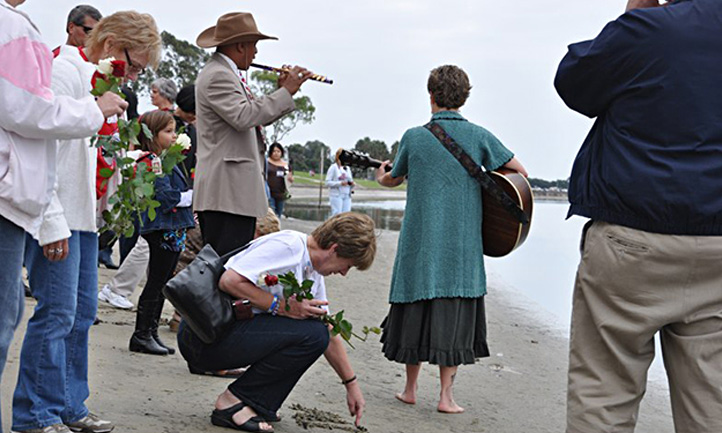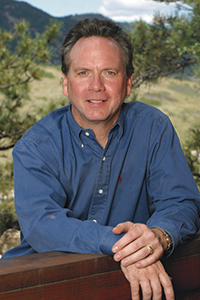Why Rituals Help Us Mourn…and Heal
Author: Alan Wolfelt
I often say that when words are inadequate, we should turn to ritual. Nowhere is this more true or important than after someone we love has died. In this article, I will explain why rituals are essential and how you can continue to use the power of ritual to help yourself and your family heal, even long after the death and funeral.

What is a ritual?
Rituals are symbolic activities that help us, together with our families and friends, express our deepest thoughts and feelings about life’s most important events. Baptism celebrates the birth of a child and that child’s acceptance into the church community. Birthday parties honor the passing of another year in the life of someone we love. Weddings publicly affirm the private love shared by two people.
What do such rituals have in common? First, they are typically public events. Families, friends, church members, villages, even nations—any group with strong emotional or philosophical ties—may create and enact a ritual, providing a support system for common beliefs and values. Rituals unite us.
Second, most rituals follow established, cultural-specific procedures. American high school graduations, for example, begin with a procession of students in cap and gown, include one or more speeches, and culminate after the graduates march across a platform to accept their diplomas. As with all rituals, the details will change somewhat from graduation to graduation, but the general pattern always remains recognizable. The predictability of ritual helps participants feel at ease. It also lends a sense of continuity, of the distillation of generations past, to those events we find most meaningful.
Finally, and perhaps most important, rituals are symbolic. Wedding rings, christening gowns, mortarboards and gold watches all symbolize important life transitions and commitments. Not just the objects but also the very acts of ritual are symbolic, as well. We blow out candles at birthday parties, for example, to symbolize the completion of another year. At a graduation ceremony’s end, the graduates toss their caps into the air to symbolize their newfound freedom. What words could we possibly utter that would capture so well our feelings at these moments? The symbol of ritual provides us a means to express our beliefs and feelings when words alone will not do those beliefs and feelings justice.
Funerals and other rituals after a death
Like the other types of ritual I have mentioned, the funeral is a public, traditional, and symbolic means of expressing our beliefs, thoughts, and feelings about the death of someone loved. Rich in history and full of symbolism, the funeral ceremony helps us begin to meet a number of our fundamental needs as mourners.
Funerals help us:
- acknowledge the reality of the death
- give testimony to the unique life of the person who died
- encourage the expression of grief
- provide support to mourners
- embrace our faith, beliefs, and questions about life and death
- find hope for our continued living
But the importance of rituals for mourners doesn’t end with the funeral. I hope you have been privileged to experience personalized, meaningful funeral ceremonies for the people in your life who have died. But whether you did or did not, here is the wonderful news: you can still marshal the healing power of ritual as you continue to mourn and heal.
Even long after the funeral, you and your family and friends can plan and carry out simple rituals that will help you continue to meet these essential needs of mourning. Below are several ideas.
Hold a tree planting
Trees represent the beauty, vibrancy, and continuity of life. A specially planted and located tree can honor the person who died and serve as a perennial memorial. This can be particularly helpful if there is no gravesite or cremation niche to visit.
The tree is a symbolic, physical presence that helps represent the person who died. When you visit the tree, it helps you remember the person who died and convert your grief (what you think and feel on the inside) into mourning (the outward expression of your grief).
Invite friends and family to attend. If the hole is dug and the tree is already placed inside it before the gathering begins, participants can help shovel loose dirt around the root ball and finish the planting.
You might write a short ceremony for the tree planting. Or ask a friend to help write one. A gathering prayer or message, a short reading, an informal sharing of memories, and perhaps a song are all you need. Consider a personalized metal marker or sign, too.
Have a candle-lighting ceremony
Invite a small group of friends. Place a lit candle in the center of a table, and form a circle around the table, with each person holding his or her own small candle.
Have each person in turn light his or her candle by holding it to the center candle’s flame. As they light their candles, participants are invited to share a memory of the person who died. At the end, play a song or read a poem or prayer in memory of the person who died.
Set aside the anniversary of the death as a holiday
As mourners, we usually don’t look forward to the anniversary of the death. We often feel particularly sad and helpless on this day. But if we turn the anniversary day into a ritual, we give ourselves something meaningful and healing to do when ordinary words and going about our day-to-day routines are inadequate.
Consider setting aside the anniversary as an annual holiday. Each year, visit the grave or scattering site. Or plan a ritual activity, such as going on a hike, hosting a family dinner, volunteering at the homeless shelter, or whatever seems most fitting.
Consider commemorating the life that was lived by doing something that the person who died could have appreciated. What were his hobbies and passions? Is there something you could turn into a ritual activity either on the anniversary of the death or on his birthday that honors what he cared about?
This special day can include a simple ceremony. Gather at a certain time and place and say a few words. Invite others to do the same. After the ceremony and activity, if there is one, share a meal. Spending this day in this way in the company of others who love you and who also loved the person who died can help all of you on your journey through grief toward healing.
A final word
Now that I’ve given you a few ideas about how to use rituals in your ongoing journey through grief, you may be able think of others. I would love to hear from you about your experiences with rituals in grief and invite you to email me at drwolfelt@centerforloss.com.
Remember: when words and interior thoughts and individual efforts alone are inadequate, we create rituals. Rituals in grief are especially powerful. I wish you good grief and Godspeed in your journey.
 By Dr. Alan Wolfelt, PhD: Dr. Alan Wolfelt is a respected author and educator on the topic of healing in grief. He serves as Director of the Center for Loss and Life Transition and is on the faculty at the University of Colorado Medical School's Department of Family Medicine. Dr. Wolfelt has written many compassionate, bestselling books designed to help people mourn well so they can continue to love and live well, including Understanding Your Grief, The Mourner's Book of Hope, and The Depression of Grief, from which this article was excerpted. Visit www.centerforloss.com to learn more about the natural and necessary process of grief and mourning and to order Dr. Wolfelt's books.
By Dr. Alan Wolfelt, PhD: Dr. Alan Wolfelt is a respected author and educator on the topic of healing in grief. He serves as Director of the Center for Loss and Life Transition and is on the faculty at the University of Colorado Medical School's Department of Family Medicine. Dr. Wolfelt has written many compassionate, bestselling books designed to help people mourn well so they can continue to love and live well, including Understanding Your Grief, The Mourner's Book of Hope, and The Depression of Grief, from which this article was excerpted. Visit www.centerforloss.com to learn more about the natural and necessary process of grief and mourning and to order Dr. Wolfelt's books.
